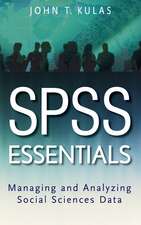Social Research Methods: Qualitative and Quantitative Approaches
Autor H. Russell Bernarden Limba Engleză Hardback – 7 mai 2012
Preț: 1222.35 lei
Preț vechi: 1674.45 lei
-27% Nou
Puncte Express: 1834
Preț estimativ în valută:
233.90€ • 254.86$ • 197.09£
233.90€ • 254.86$ • 197.09£
Carte tipărită la comandă
Livrare economică 23 aprilie-07 mai
Livrare express 19-25 martie pentru 63.03 lei
Preluare comenzi: 021 569.72.76
Specificații
ISBN-13: 9781412978545
ISBN-10: 1412978548
Pagini: 824
Dimensiuni: 178 x 254 x 38 mm
Greutate: 1.43 kg
Ediția:Second Edition
Editura: SAGE Publications
Colecția Sage Publications, Inc
Locul publicării:Thousand Oaks, United States
ISBN-10: 1412978548
Pagini: 824
Dimensiuni: 178 x 254 x 38 mm
Greutate: 1.43 kg
Ediția:Second Edition
Editura: SAGE Publications
Colecția Sage Publications, Inc
Locul publicării:Thousand Oaks, United States
Recenzii
“The main strength of this text is coverage of both quantitative and qualitative methodology from a broad range of fields. The examples are often my students’ favorite thing to discuss in class.”
“Bernard does an excellent job of not only showing how to practice research, but also provides a detailed discussion of broader historical and philosophical contexts that are important for understanding research.”
“The book includes a thorough presentation of quantitative and qualitative methods, including formulas and statistics for quantitative methods. Bernard is one of very few methods authors who includes and explains statistical methods, not just the methods used. Moreover, the book is very comprehensive and uses lots of examples to explain the material in depth.”
“The depth of detailed descriptions (foundations of social research; interviewing, participant observation, field notes, and data analysis) go beyond other texts that I’m aware of, and the organization is superb. The text contains strong descriptions of positivist versus humanistic traditions and splits in social research. It also includes great detail on how to successfully operationalize research variables. The discussion on theory as a “mechanism” and how to choose problems is easily understood and effective. Moreover, the author’s emphasis on making personal interest a high priority in choosing a research topic is critical and primary.”
'There is considerable detail on the history and philosophical foundations of social and behavioural research, ranging from the ‘what’ to the ‘how-to’ of social research.
To make sure the message of each chapter is clearly communicated [Bernard] employs a wealth of examples and reading lists. He also provides the reader with a description of key concepts employed in each chapter.'
“Bernard does an excellent job of not only showing how to practice research, but also provides a detailed discussion of broader historical and philosophical contexts that are important for understanding research.”
“The book includes a thorough presentation of quantitative and qualitative methods, including formulas and statistics for quantitative methods. Bernard is one of very few methods authors who includes and explains statistical methods, not just the methods used. Moreover, the book is very comprehensive and uses lots of examples to explain the material in depth.”
“The depth of detailed descriptions (foundations of social research; interviewing, participant observation, field notes, and data analysis) go beyond other texts that I’m aware of, and the organization is superb. The text contains strong descriptions of positivist versus humanistic traditions and splits in social research. It also includes great detail on how to successfully operationalize research variables. The discussion on theory as a “mechanism” and how to choose problems is easily understood and effective. Moreover, the author’s emphasis on making personal interest a high priority in choosing a research topic is critical and primary.”
'There is considerable detail on the history and philosophical foundations of social and behavioural research, ranging from the ‘what’ to the ‘how-to’ of social research.
To make sure the message of each chapter is clearly communicated [Bernard] employs a wealth of examples and reading lists. He also provides the reader with a description of key concepts employed in each chapter.'
Cuprins
Part I: Background to Research
Chapter 1. About Social Science
Chapter 2. The Foundations of Social Research
Chapter 3. Preparing for Research
Part II: Research Design
Chapter 4. Research Design: Experiments and Experimental Thinking
Chapter 5. Sampling: The Basics
Chapter 6. Sampling Theory
Chapter 7. Nonprobability Sampling
Part III: Data Collection
Chapter 8. Interviewing I: Unstructured and Semistructured
Chapter 9. Interviewing II: Questionnaires
Chapter 10. Interviewing III: Relational Data - Domains and Networks
Chapter 11. Scales and Scaling
Chapter 12: Participant Observation
Chapter 13. Field Notes and Database Management
Chapter 14: Direct and Indirect Observation
Part IV Data Analysis
Chapter 15: Introduction to Qualitative and Quantitative Analysis
Chapter 16: Analyzing Cultural Domains and Proximity Matrices
Chapter 17. Analyzing Qualitative Data I: Applying Logic to Text
Chapter 18. Analyzing Qualitative Data II: Grammar Beyond the Sentence
Chapter 19. Analyzing Qualitative Data III: Grounded Theory and Content Analysis
Chapter 20. Univariate Analysis
Chapter 21. Bivariate Analysis: Testing Relations
Chapter 22. Multivariate Analysis
Appendix A: Table of Areas under a Normal Curve
Appendix B: Student’s t Distribution
Appendix C: Chi-Square Distribution Table
Appendix D: F Table for the .05 Level of Significance
Appendix E: Resources for Social Researchers
Chapter 1. About Social Science
Chapter 2. The Foundations of Social Research
Chapter 3. Preparing for Research
Part II: Research Design
Chapter 4. Research Design: Experiments and Experimental Thinking
Chapter 5. Sampling: The Basics
Chapter 6. Sampling Theory
Chapter 7. Nonprobability Sampling
Part III: Data Collection
Chapter 8. Interviewing I: Unstructured and Semistructured
Chapter 9. Interviewing II: Questionnaires
Chapter 10. Interviewing III: Relational Data - Domains and Networks
Chapter 11. Scales and Scaling
Chapter 12: Participant Observation
Chapter 13. Field Notes and Database Management
Chapter 14: Direct and Indirect Observation
Part IV Data Analysis
Chapter 15: Introduction to Qualitative and Quantitative Analysis
Chapter 16: Analyzing Cultural Domains and Proximity Matrices
Chapter 17. Analyzing Qualitative Data I: Applying Logic to Text
Chapter 18. Analyzing Qualitative Data II: Grammar Beyond the Sentence
Chapter 19. Analyzing Qualitative Data III: Grounded Theory and Content Analysis
Chapter 20. Univariate Analysis
Chapter 21. Bivariate Analysis: Testing Relations
Chapter 22. Multivariate Analysis
Appendix A: Table of Areas under a Normal Curve
Appendix B: Student’s t Distribution
Appendix C: Chi-Square Distribution Table
Appendix D: F Table for the .05 Level of Significance
Appendix E: Resources for Social Researchers
Notă biografică
Descriere
Using genuine examples from across the social sciences the Second Edition provides extensive in depth treatment of the subject matter to provide readers with both a conceptual understanding of each method as well as showing them how to apply it.









